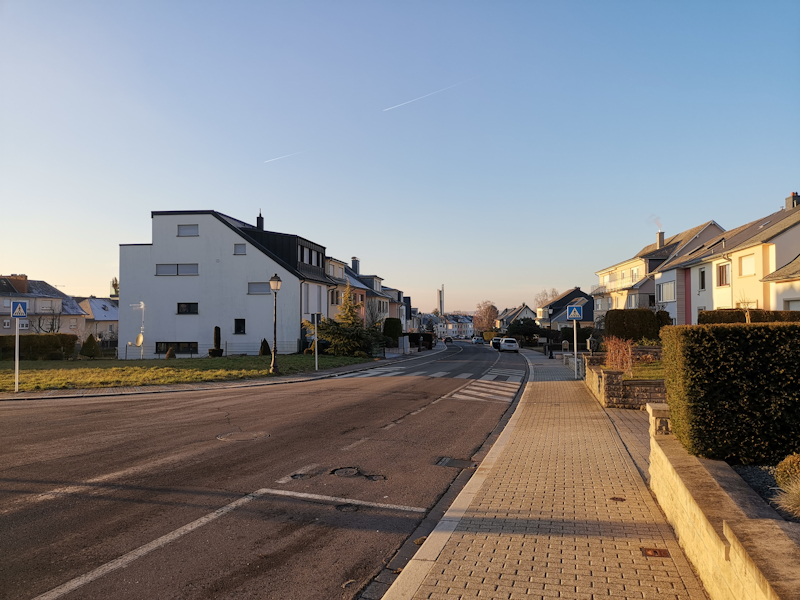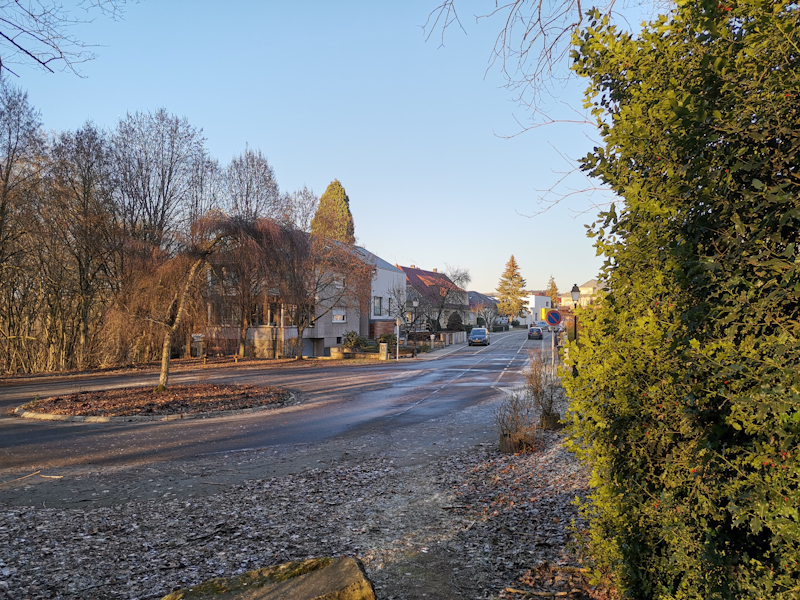Honor Launches The View20: A 48MP Camera Review
by Andrei Frumusanu on January 28, 2019 8:00 AM EST- Posted in
- Smartphones
- Mobile
- Kirin 980
- Honor View20
Camera - Daylight Evaluation
While this isn’t a full review, the one aspect of the View20 that I definitely wanted to cover for the launch embargo is the new camera. Honor makes a lot of promises for the View20, an in particular there’s a new “AI Ultra Clarity” mode which promises to improve detail retention in the full 48MP mode in bright lightning conditions.

[ Honor View20 ] - [ Mate 20 Pro ]
[ Galaxy Note9 ] - [ Galaxy S9+ ] - [ LG V40 ]
[ OnePlus 6T ] - [ Pixel 3 ]
In the first scene, the View20 in its default 12MP capture mode performed very well and does look like it represents an increase in detail over the Mate 20 Pro’s 10MP mode. Dynamic range processing between these two devices looks to be very similar, although I do feel they both are too warm and not as realistic as some other the competition phones.
In 48MP mode, we see some of the inherent disadvantages of the sensor as similar results to last year’s 40MP units from Huawei: the picture unfortunately loses out in dynamic range and this is particularly visible in the darker and less detailed shadows. The shadows in the View20 are darker than the Mate 20 Pro, however the highlights on the View20 are more pronounced. Another difference in the new sensor is seemingly better detail retention on textures, pointing out to better DTI of the new sensor. While textures are improved on the View20, one aspect where it does clearly lag behind is in the clarity of the branches of the tree. I think this could point out to a worse quality lens on the part of the View20 as it does looks like a typical case of chromatic aberration.
Using the AI Clear mode (“Clear mode” from here on forth) we see the picture regain some of the dynamic range that was lost by using the 48MP mode. While this was an improvement, the detail in this scene suffered tremendously as we see a heavy noise filter on the whole image just blur out details in an indiscriminate fashion, making this a huge miss for this mode in this first scene. I’m not sure what happened here, it could be that the firmware still has some bugs as under closer inspection it does look more like a 12MP result even though the phone was set to 48MP clear mode.

[ Honor View20 ] - [ Mate 20 Pro ]
[ Mate 20 ] - [ Galaxy Note9 ] - [ Galaxy S9+ ]
[ LG V40 ] - [ OnePlus 6T ] - [ Pixel 3 ]
In the second scene, we have a quite different result compared to the first shots. In 12MP mode again the processing was extremely similar to the Mate 20 Pro’s 10MP mode, with just a slight advantage in detail for the new phone. While on paper this 12MP mode should be somewhat equal or actually even superior to other 12MP phones, it’s actually not the case as the phone still trails the effective spatial resolution produced by the Note9.
Switching over to 48MP mode, the View20 now actually leads in terms of resolved detail. Here again it’s visible that the new sensor is a definitive upgrade compared to the 40MP unit in the Mate 20 Pro.
Turning on clear mode again, we now actually see a big beneficial effect on the picture quality as the resulting image has better dynamic range and also its detail retention is overall improved in the whole of the shot. The resulting shot is definitely leagues ahead of any other phone in terms of sheer detail, although it comes at a cost of reduced dynamic range and shadows.

[ Honor View20 ] - [ Mate 20 Pro ]
[ Mate 20 ] - [ Galaxy Note9 ] - [ Galaxy S9+ ]
[ OnePlus 6T ] - [ Pixel 3 ]
The in the next tree stump shot, between the 12MP and 48MP clear mode shots, the exposure and resulting dynamic range of both shots are virtually indistinguishable. Under closer inspection, this again looks to be a dud shot for some reason as the 48MP clear mode shot doesn’t actually have any better spatial resolution than the 12MP shot, a similar result to our first scene.
Clear mode aside for now, the normal 48MP shot has some fantastic level of detail, again showcasing the much better DTI compared to its 40MP brethren in the Mate 20 Pro.
Finally back in the 12MP mode, the View20 showcases exemplary dynamic range, although again it loses out in terms of detail compared to say the Note9 or OnePlus 6T.

[ Honor View20 ] - [ Mate 20 Pro ] - [ Mate 20 ]
[ Galaxy Note9 ] - [ Galaxy S9+ ] - [ LG V40 ] - [ OnePlus 6T ] - [ Pixel 3 ]
In a similar scene, but this time with the sun more brightly lighting up details, we see the clear mode again actually be useful as it’s able to better retain details throughout the scene. At this focal distance, we again see some issues compared to the result of the Mate 20 Pro; the latter image is again much sharper and the type of blurriness we’re seeing is again what one would traditionally attribute to lesser quality optics.
This detriment isn’t nearly as visible in 12MP mode, and here the View20 showcases again excellent dynamic range as probably the best exposed results among the tested smartphones.

[ Honor View20 ] - [ Mate 20 Pro ] - [ Mate 20 ]
[ Galaxy Note9 ] - [ Galaxy S9+ ] - [ LG V40 ] - [ OnePlus 6T ] - [ Pixel 3 ]
This last scene is quite harsh in terms of the dynamic range requirements. Nevertheless, the 12MP mode of the View20 manages to breeze through this aspect of the shot, taking full advantage of the characteristics of the quad-bayer sensor setup.
The 48MP mode in this shot is a good showcase how the sensor loses out in dynamic range when using its “full resolution”. Clear mode here does manage to regain some of the dynamic range back, and again for this scene we see a beneficial effect on details.
It’s an improvement, but high MP sensors still aren’t worth the double-edged sword
My experience with the View20 and the new IMX586 sensor pretty much mirror what I’ve come to experience with the 40MP sensors of the P20 Pro and Mate 20 Pro. The high megapixel count can definitely be useful to resolve more detail at a micro level of a picture, however these capture modes come with a big double edged sword side-effect of much worse dynamic range at the macro level of a picture.
In every-day use-cases, I don’t recommend using the 48MP modes of the View20, as much as on the P20 Pro and Mate 20 Pro, it comes with too many compromises. Huawei defaults its settings to 10MP on its phones, and this makes sense. Honor on the View20 also defaults to 12MP mode, however the inclusion of its new 48MP “AI Ultra Clear” mode complicates things for the users as it’s not exactly clear which mode is better to use. First of all, as seen in several scenes here today, the clear mode seems to be buggy and resulting in 12MP quality pictures even though the output image is 48MP in resolution. More important than this, and even though the clear mode does improve on this, the loss in dynamic range remains disappointingly big, which can cause for bad images in challenging capture scenarios.
The View20’s sensor does look like a straight improvement over the 40MP unit on the P20 Pro and Mate 20 Pro – however it’s also seemingly clear that the new phone doesn’t have as good optics as the Huawei flagships. Here it does look like the Huawei’s counterparts Leica optics actually are actually worth their marketing promises.
What the View20’s camera ends up in low-light is as an excellent 12MP shooter with great exposure and dynamic range characteristics. It’s not going to win in terms of detail, but it’s sufficiently good enough that it shouldn’t represent a deal-breaker. Overall though I do wish we’d see Huawei or Honor employ a top-range low MP sensor in their phones and measure such as setup again competing flagships.










37 Comments
View All Comments
apphil - Monday, January 28, 2019 - link
One thing I am extremely curious is the performance of the GPS chip as it is one of the first phones with L5 GPS and this should increase accuracy a lot. Can you guys comment on that or maybe test that, as better navigation and positioning would be a very interesting feature for me.Andrei Frumusanu - Monday, January 28, 2019 - link
One of the benefits of this was in more urban areas with tall buildings, unfortunately I wasn't able to actually test this out. The phone's location APIs also does not disclose whether it sees L5 satellites or not - usually you see it when there's a duplicate ID, however this does not appear on the View20.808Hilo - Monday, January 28, 2019 - link
The cam is disappointing. Can we just have a big sensor and a manual lensring of my choice and 4k or 8k raw at 30fs the back. NOW!!!Its not difficult. Just do it. Nikon in my case. I got a nice selection of 8-50mm lenses and dont want yours.
Engineering a phone is not difficult. Adding a lensring and a big sensor is a breeze.
Valantar - Monday, January 28, 2019 - link
Difficult? Not if you don't care about size, no. The flange distance of the Nikon Z-mount is 16mm, for their F-mount it's 46.5mm. Add a handful of mm to that for the display, and 10 or so for the sensor and shutter array - more if you want IS. That's a chunky phone, even with a Z-mount. And constructing lenses for shorter flange distances with large sensors is _extremely_ difficult, as you'll have to correct for ever more distortions towards the outer parts of the sensor. Of course they could have spacer rings or similar to adapt lenses, but that would kind of defeat the point, no? You wouldn't be able to fit it in your pocket unless you're wearing MC Hammer pants. Also, 8k30 in a phone? At what bitrate, 50Mbps? For any bitrate worth the pixels in 8k, you'd need storage in the several-hundred-GB amounts for even a collection of short clips, and the processing power needed would require large interchangeable batteries - unless you want your phone to die after filming for 5 minutes? And good luck getting that video material off a phone with non-removable storage in a reasonable amount of time. I suppose you'd want it to have an SSD bay too?hanselltc - Monday, January 28, 2019 - link
>Engineering a phone is not difficultbuild ur own phone m8 :v
Manch - Monday, January 28, 2019 - link
TOF sensor would be great for 3D scanning! Why not have an app to take advantage!jabber - Monday, January 28, 2019 - link
You know I'd settle for a truly excellent 8MP main cam to be honest.Forget going mega megapixel. Just get the fundamentals right first.
shabby - Monday, January 28, 2019 - link
Nothing to do with megapixels in this case, the sensor is great, everyone uses sony sensors, its the isp and software that sucks. The isp on these chinese made soc's is way behind the snapdragon isp.Heck even sony doesn't know how to fully take advantage of its own sensor. The pixel 3 and pocophone use the same sensor and we all know which phone takes the best photo's.
Midwayman - Monday, January 28, 2019 - link
Yes. This. Especially with more phones putting on more than a single lens. I care way more about the quality of the pixels than the quantity of pixels. 48mp photos just take up more space if they are just a grainy mess in anything but the brightest light.jabber - Tuesday, January 29, 2019 - link
Exactly. They spend all the time fussing over the sensor and then throw out the lens/flash/focusing/software/compression/NR features.I bet the sensors from 4 years ago would beat most current flagships if they bothered to spend more than a weeks development on all the other fundamentals.